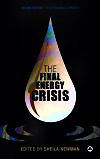
Nothing is more vital to the survival of human populations than an abundant flow of cheap energy. Most well-informed persons are vaguely aware that oil and gas supplies are peaking or have now peaked; yet there are still government departments and many news media that would prefer to know and think about this as little as possible.
First published in People and Place magazine Volume 17 No 2 of 2009. See also: Final Energy Crisis blogs, Mark O'Connor's web site, australianpoet.com, review of Mark O'Connor's Overloading Australia.
Survival
Nothing is more vital to the survival of human populations than an abundant (if possible an infinite) flow of cheap energy. This is what we thought we had all through the 20th century, and what we now find we do not. Most well-informed persons are vaguely aware that oil and gas supplies are peaking or have now peaked; yet there are still government departments and many news media (including as yet ABC TV Current Affairs) that would prefer to know and think about this as little as possible. Despite warnings from the Australian Commonwealth Scientific and Industrial Research Organisation and the Australian Academy of Science, the possibility that a future Australia might lack the fossil energy to transport food to its cities, or to make the nitrate fertilizers and import the heavy rock phosphates without which crops won't grow, has had as yet no effect on Australia's population or immigration policies.
Growth Economics and Australia's population numbers
Growth economists and many who see themselves as experts in fine-tuning immigration policy do not find it easy to accept limits to growth. Yet a piece of stockmarket wisdom runs: 'If something can't go on for ever, sooner or later it won't.' The current population boom, which has Australia's population growing at nearly two per cent a year and, if this growth rate continues, on course to pass 100 million by the end of the century, almost certainly won't.
A World running out of energy
This collection of essays on a world running out of energy first appeared in 2005. It has now been re-edited, and updated. Twenty of the twenty-four chapters are new or substantially re-written. Sheila Newman, the Australian polymath who co-edited the first edition with the international energy economist Andrew MacKillop, is now the sole editor. Indeed much of the book is the Sheila Newman show. She has pulled together an impressive range of technical experts, including Seppo Korpela and Colin Campbell, then expanded the book's range through her wide-ranging introductions to each section. She also contributes nine of the book's 24 chapters, plugging what might otherwise be gaps in the argument.
How the world energy system works
Population and demography are not the main focus of this book, but they are issues waiting in the wings of every chapter. It is taken as read that if there were fewer people our energy options would expand, and vice versa. Yet the main focus is on why the world's energy system currently works the way it does -- and why it can't go on like this much longer.
A chilling future dystopia for Australia
However the chapter, 'France and Australia after Oil', canvasses a chilling future dystopia for Australia. A century or more into the future, if we keep on growing Australia's population while energy runs short, she predicts a much leaner Australian society -- one that its present inhabitants might not recognise. (Note though that Mark Diesendorf's Greenhouse Solutions with Sustainable Energy, UNSW Press 2007, argues that renewable energy can, if very carefully managed, sustain the present population.)
Bilingual author pitched to compare different political systems
Bilingual in French and English, Sheila Newman regularly contrasts the economic culture of three pioneering Anglophone countries (Australia, USA, Canada) with the more conservative economic and energy policies of France and much of Europe. By contrast the Anglo cultures, she writes, allowed the drawdown of fossil fuels to be 'multiplied by the needs of a much greater population'.
Different energy sources, different population carrying capacities
The population that can be sustained by oil is vastly larger than the one that coal could have made possible, which in turn dwarfs the less than one billion humans that wood and natural biomass could have powered. How many of the present six to seven billions will be able to survive when the age of cheap oil and gas (and therefore, presumably, of cheap fertilizers) ends? Will Caspian oil, solar power, wind, or nuclear fusion save us?
Many peaks investigated in this book
The book's experts take us through the fascinating problems of peak oil, peak nitrate fertilizer, peak phosphorus, peak soil, geopolitical struggles for oil, China's car explosion, natural gas, coal emissions, nuclear fission, nuclear fusion—and possible alternative (or post-disaster) life-styles. I for one emerged vastly better informed -- and about issues I thought I had more or less known.
The Final Energy Crisis, edited by Sheila Newman, Pluto Press, UK, 2008, ISBN 0-7453-2717-6, A$44.50 in Australia, from Palgrave Macmillan, US$26.66 from Amazon
Author note: Mark O'Connor is a co-editor of Protected Area Management (Oxford University Press, 2001), and co-author of Overloading Australia (Envirobook, 2008)
This review first published in People and Place magazine Volume 17 No 2 of 2009.
See also: Final Energy Crisis blogs, Mark O'Connor's web site, australianpoet.com, review of Mark O'Connor's Overloading Australia.

Comments
KaitlinB (not verified)
Tue, 2011-02-15 20:40
Permalink
Natural gas or alternative
Add comment